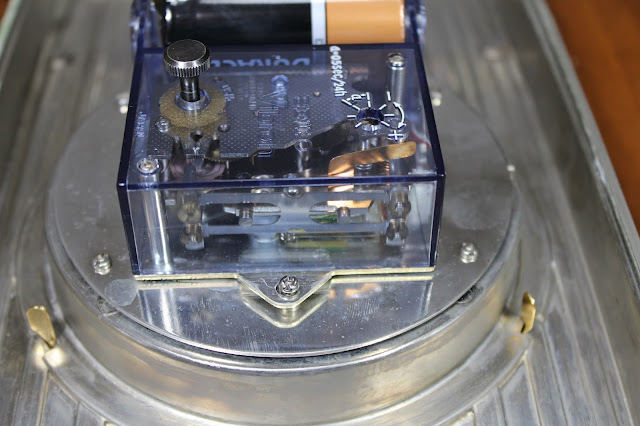Lord King World Time Jet aircraft balance-wheel battery clock Japan c1970
Significance
A "Lord King" World Time, balance-wheel, battery novelty clock Japan c1970 with jet aircraft second-hand. I bought it as a novelty clock, but it is also an example of electromechanical clocks c1970, in the few years before quartz clocks dominated.The Japanese movement is predominately plastic, including the gears, presumably to reduce costs; an ongoing theme in manufacturing. The assembly of the clock would be similar to any mechanical clock, requiring nimble fingers.
The clock has a Jumbo jet aircraft on a round plastic disc as its second hand. The outer dial shows world time against the current local time of the clock. The clock is characteristic of the new jet age of the 1970s with the introduction of Jumbo jets in the late 1960s.
Why collect these? My collecting interest is clock technology and clock industry history... and any cute clock. This clock is nearly 50 years old and characteristic of electromechanical clocks just before quartz clocks dominated. They are quite inexpensive now but that may not always be the case as recent technology items tend to be junked.
Description
The first impression is its considerable weight, 1.3 kg, quite unexpected for a 1970s Japanese clock. It was probably reasonably expensive given the then-new design of the electromechanical movement. The ends are real-wood veneer on plywood, the top and bottom, aluminium, and the front and back, glass, thus explaining the weight.The movement is intriguing. A D-cell battery powers a small DC motor driving a worm gear. It engages with a round gear to power the mechanism. There is a contact to switch the motor, presumably the motor winds a small spring, but I could not see it. The balance-wheel and escapement are conventional as is the rest of the mechanism. There is a fast/slow adjustment for the balance-wheel via hairspring tension. There is no mention of the number of jewels in the movement. While not measured yet, the clock is likely to be reasonably accurate given its mechanism.
The manufacturer of the movement is unclear, but possibly Seiko, maybe NEC. The movement was used in a number of clocks including for advertising, such as Miller beer.
Source: Local, via Facebook Marketplace, posted from Brisbane. Cost is low for now.
The movement minus a plastic cover.
The electromechanical movement. The DC motor driving a worm gear is top left. The balance-wheel and escapement are bottom left. A speed adjustment and hands adjustment.
A detail showing the balance-wheel at bottom left.







Comments
Post a Comment